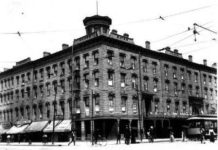This dark skinned, coarse, vacant-eyed, curly-haired man is the closest possible likeness of the historical Jesus, according to the latest forensic techniques.
![image-38-e1458590984596[1]](https://coolinterestingnews.com/wp-content/uploads/2016/03/image-38-e14585909845961.jpeg)
From the first time Christian children settle into Sunday school classrooms, an image of Jesus Christ is etched into their minds. In North America he is most often depicted as being taller than his disciples, lean, with long, flowing, light brown hair, fair skin and light-colored eyes. Familiar though this image may be, it is inherently flawed. A person with these features and physical bearing would have looked very different from everyone else in the region where Jesus lived and ministered. Surely the authors of the Bible would have mentioned so stark a contrast.
class=”ad-gpt-breaker-container”>On the contrary, according to the Gospel of Matthew, when Jesus was arrested in the garden of Gethsemane before the Crucifixion, Judas Iscariot had to indicate to the soldiers whom Jesus was because they could not tell him apart from his disciples. Further clouding the question of what Jesus looked like is the simple fact that nowhere in the New Testament is Jesus described, nor have any drawings of him ever been uncovered.
There is the additional problem of having neither a skeleton nor other bodily remains to probe for DNA. In the absence of evidence, our images of Jesus have been left to the imagination of artists. The influences of the artists’ cultures and traditions can be profound, observes Carlos F. Cardoza-Orlandi, associate professor of world Christianity at Columbia Theological Seminary in Atlanta. “While Western imagery is dominant, in other parts of the world he is often shown as black, Arab or Hispanic.” And so the fundamental question remains: What did Jesus look like?
An answer has emerged from an exciting new field of science: forensic anthropology. Using methods similar to those police have developed to solve crimes, British scientists, assisted by Israeli archeologists, have re-created what they believe is the most accurate image of the most famous face in human history.
The Body As Evidence
An outgrowth of physical anthropology, forensic anthropology uses cultural and archeological data as well as the physical and biological sciences to study different groups of people, explains A. Midori Albert, a professor who teaches forensic anthropology at the University of North Carolina at Wilmington. Experts in this highly specialized field require a working knowledge of genetics, and human growth and development. In their research they also draw from the fields of primatology, paleoanthropology (the study of primate and human evolution) and human osteology (the study of the skeleton). Even seemingly distant fields like nutrition, dentistry and climate adaptation play a role in this type of investigation.
While forensic anthropology is usually used to solve crimes, Richard Neave, a medical artist retired from The University of Manchester in England, realized it also could shed light on the appearance of Jesus. The co-author of Making Faces: Using Forensic And Archaeological Evidence, Neave had ventured in controversial areas before. Over the past two decades, he had reconstructed dozens of famous faces, including Philip II of Macedonia, the father of Alexander the Great, and King Midas of Phrygia. If anyone could create an accurate portrait of Jesus, it would be Neave.
Reconstructing Jesus
Matthew’s description of the events in Gethsemane offers an obvious clue to the face of Jesus. It is clear that his features were typical of Galilean Semites of his era. And so the first step for Neave and his research team was to acquire skulls from near Jerusalem, the region where Jesus lived and preached. Semite skulls of this type had previously been found by Israeli archeology experts, who shared them with Neave.
With three well-preserved specimens from the time of Jesus in hand, Neave used computerized tomography to create X-ray “slices” of the skulls, thus revealing minute details about each one’s structure. Special computer programs then evaluated reams of information about known measurements of the thickness of soft tissue at key areas on human faces. This made it possible to re-create the muscles and skin overlying a representative Semite skull.













